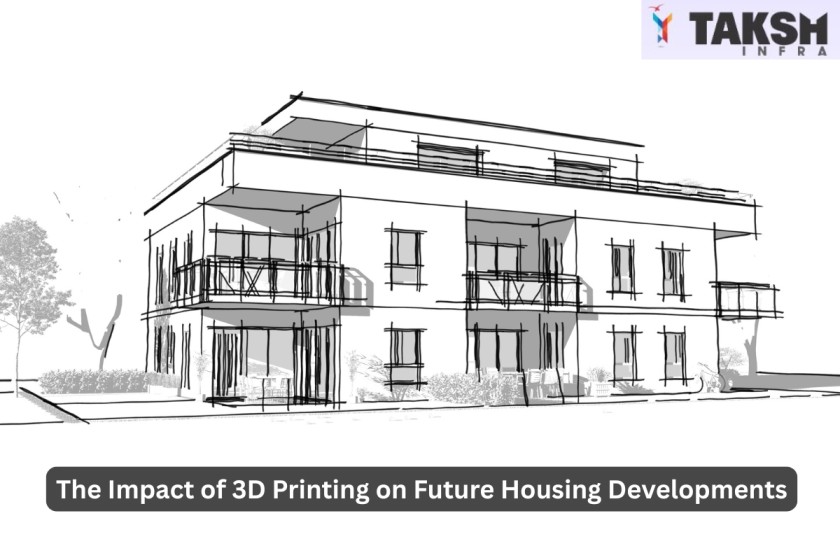Table of Contents
- Introduction
- What is 3D printing in housing?
- How 3D printing will revolutionize housing developments?
- Benefits of 3D printing in construction
- Challenges to overcome in 3D printing for housing
- The future of 3D printing in housing
- Conclusion
- FAQs
Introduction
The real estate industry is evolving very rapidly. With the newest technologies, new methods are being explored to simplify housing construction. One of them is 3D printing. 3D printing, also known as additive manufacturing, revolutionizes homes in a design and manufactured manner. Therefore, it allows buildings and structures to be made from computer models that lay layer by layer. But how will 3D printing revolutionize the future of housing developments?
In this blog, we will be talking about how 3D printing is changing the construction sector. We will also observe how real estate developers in Vadodara and Vadodara leading builders can apply this technology. Additionally, we’ll analyze the role of the best construction companies of Vadodara in adopting this technology for the future.
What is 3D printing in housing?
3D printing in building construction is the technique of using a 3D printer to construct a house’s framework. Unlike traditional techniques, where workers assemble materials like bricks and concrete, 3D printers use computer instructions to build the framework in layers. From concrete to recycled plastic, the material used in 3D printing can be different. The method can provide houses in record time with minimal wastage.
Yet, it should be noted that 3D printing is not yet extensively applied to all housing developments. It remains a new technology in the real estate industry. As more developers and builders try out this technology, its application will become more prevalent in housing developments.
How will 3D printing revolutionize housing developments?
3D printing can change the housing future. As more and more of the best construction company in Vadodara begin adopting this technology, home building will undergo a complete transformation. Here’s how:
- Faster Construction: Traditional housing construction also takes months or years. 3D printing enables homes to be made within a week or a week. Rapid construction is particularly beneficial where there is a lack of housing or reconstruction after the disaster.
- Low cost: 3D printing reduces the labor cost of traditional construction. There is less material that is ruined, and less laborers are required. Low cost makes it more inexpensive for both buyers and builders.
- Flexible: 3D printing can be used for complex and individual designs that will prove to be very expensive or time consuming when manufactured in regular methods. Therefore, designer customs can build durable homes that are specially designed to suit specific customers.
- Fewer Wastes: During the traditional process, a large quantity of the material gets wasted. 3D printing takes just what it needs, so less waste, and it is ecologically friendly.
Benefits of 3D printing in construction
Application of 3D printing in house construction has numerous advantages:
- Speed: As previously explained, 3D printing allows construction to be quicker.
- Customization: Home purchasers can have their houses built the way they desire, which was not possible earlier.
- Cost Effectiveness: With reduced use of material and reduced labor cost, houses are affordable.
- Sustainability: 3D printing can be done using environmentally friendly materials such as recycled plastic; therefore, the process is made more durable.
However, despite all these benefits, there are some drawbacks to the use of 3D printing in the construction of buildings. These drawbacks are limited access to 3D printing machines and the need for operators.
Challenges to overcome in 3D printing for housing
Even though 3D printing has various benefits, challenges have to be overcome before it becomes a standard for home construction. Some of the biggest challenges are.
- Technology Limitations: 3D printers for housing are new, and some of them have constraints. The size of the 3D printer defines the size of the houses it can build. Bigger printers will need to be developed to construct larger buildings.
- Regulation and Codes: Building codes and regulations are put in place for traditional construction methods. For 3D printing to become a common practice, these codes will need to be updated to include the new technology.
- Initial Investment: While 3D printing saves money in long periods, training staff can prove to be expensive to get initial investment and 3D printer. However, as the popularity of technology increases, the prices of equipment should be low.
- Workforce with Training: Builders and construction workers would need to undergo training to learn how to utilize 3D printers and to understand the technology. Currently, there are very few skilled experts in this domain.
The future of 3D printing in housing
The future of housing development will be determined by technology, such as 3D printing, in the future. The technology has future potential, especially in cities and regions with low access to housing. Below are some of the possibilities:
- Affordable Housing: As there will be greater usage of 3D printing, houses will become affordable to everyone. Vadodara property developers, for example, can help alleviate housing shortages by adopting the use of 3D printing techniques.
- New Architecture: Using 3D printing, structures can be constructed with complicated designs and configurations that are not possible with conventional building materials. Be on the lookout for novel and new architectural designs in the future.
- Global Reach: As the technology becomes more universal, countries around the world will adopt 3D printing in building housing. This will improve housing supply, particularly in disaster zones or poor areas.
Conclusion
Finally, 3D printing can change the housing industry in numerous ways. It brings benefits such as reduced construction time, affordability, and reduced wastage. Despite challenges such as regulation and technical limitations, the future of residential buildings using 3D printing is bright. Moreover, Vadodara real estate companies, top builders in Vadodara, and top construction companies in Vadodara are well-positioned to benefit the most from this technology. They are able to transform house buildings into something useful and help prevent housing shortages in their regions by doing so.
Furthermore, as technology is moving forward, we can expect more durable, low cost and innovative homes manufactured through 3D printing techniques. The future of home building is bright, in fact, and 3D printing will play an important role in shaping the future.
FAQs
- What is 3D printing in housing?
3D building uses a machine to construct a layer of houses layer by layer from computer-aided models. It is faster, cheaper, and more resilient than traditional buildings.
- How will 3D printing revolutionize the construction industry?
3D printing will reduce low cost and waste and allow for more flexible, sustainable designs. This is a better way of constructing houses in the future.
- Would 3D-printed houses be safe to live in?
Yes, 3D-printed homes are safe if material is used appropriately and according to the rules. Technology employs strong material that provides strength and stability for enduring life.
- What are the constraints of 3D printing in residential construction?
Constraints are high initial cost, technology constraints, and the need for skilled labor. Furthermore, building codes and regulations need to be modified to accommodate 3D-printed homes.





